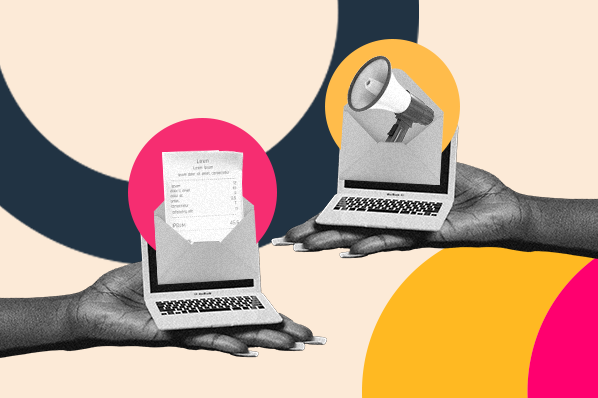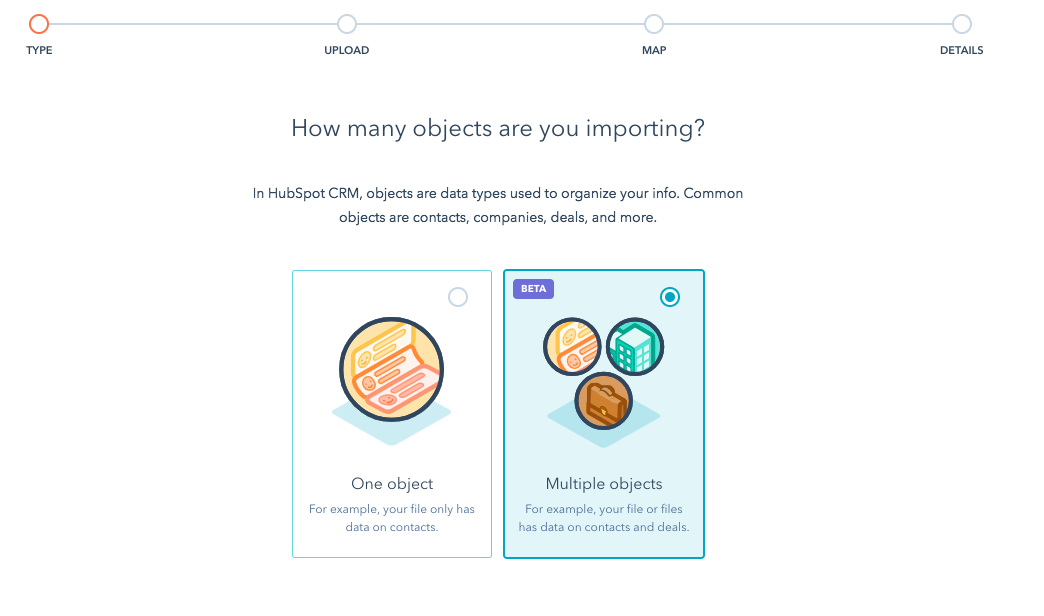Part of the reason for vague descriptions is because email sending laws vary significantly between countries and any advice given on email may apply to one country, but may get you into trouble in another. So how do we differentiate marketing email and transactional email? Let's dive in.
Definition of Marketing & Transactional Email
Before we get to differences, and what type of email you should send let's define the two email types were talking about.
Marketing Email: Any email sent that primarily contains a commercial message or content intended for a commercial purpose (i.e. nurturing leads through your funnel) is considered a marketing email and must follow local laws. Marketing email is generally sent to groups of contacts that are prospects or customers.
There are tons of marketing emails tools including HubSpot, Mailchimp, Constant Contact, and more.
Transactional Email: One-to-one emails that contain information that completes a transaction or process the recipient has started with you. A common example is in ecommerce, after purchasing an item you receive an email receipt that has information about the item, price, and shipment. Transactional email is sent to individuals rather than a large list of recipients.
While HubSpot offers a transactional email feature, there are also tons of dedicated transactional emailing tools including Sidemail, Postmark, Mailersend, and more.
Boost Opens & CTRs with HubSpot's Free Email Marketing Software

Now that we have definitions, let's expand on both of those cases and talk about a few examples of marketing and transactional emails. As we talked about above, a marketing email is content that is intended for a commercial purpose. A newsletter is a great example of this, because it's intended to drive the recipient towards making a purchase or downloading content that brings them further down the funnel.

I recently received this newsletter from Men's Wearhouse which highlights a daily deal, and related items that the recipient may be interested in purchasing. In this case, it's obvious that this is considered a marketing email. But what about all of those emails you send to promote content and get visitors to download offers?
It's more of a gray area, but it's safe to expect most of that email to also be marketing related as it's intended purpose is to educate and drive clients/customers to some expected commercial transaction, whether that's making a purchase, upgrading their subscription, or anything that is related to a commercial deal or transaction.
Want more content like this? Subscribe to the User Blog.
Here are a few emails that are likely marketing-related:
- Email Newsletters
- Content Promotion & Offers
- Sales Emails & Communication
1. Order Confirmation or Receipt
Transactional email is different and contains critical information that is relevant to each recipient. For example, after recently purchasing a new modem, Amazon let me know that the modem had shipped and enabled me to track the package.
 As you can see this email is personalized to me and contains information that is based on my previous transactional behavior with Amazon. If you have recently purchased an item from any ecommerce store, it's likely you've seen an email very similar to this.
As you can see this email is personalized to me and contains information that is based on my previous transactional behavior with Amazon. If you have recently purchased an item from any ecommerce store, it's likely you've seen an email very similar to this.
But wait... I'm sure you noticed in the Amazon email example there is a section on items that are related to the purchase made. Doesn't this seem like a marketing email?
Good catch.
This is where the line between marketing email and transactional email, as well as legality, gets blurred very easily. There is no one right answer that will fit every countries email sending laws, and to highlight this lets use the Amazon email as an example with U.S. CAN-SPAM laws and the Canadian Anti-Spam Legislation.
In the U.S. this Amazon email would likely be considered transactional as it's primary purpose is based on my commercial relationship with Amazon. What I mean is, the email subject is about my order, the first information I see is about my package, where it was shipped, and details of the order, and then secondary to all of that other content, are a few related items others have bought. In Canada (or if this email was being sent to someone in Canada), it's not ok to include related items within your transactional email, and the whole frequently purchased section would have to be removed.
Here are a few emails you can send that are transactional: (again, ensure any content you include within your email adheres to local email sending laws and practices before sending the email)
- Commerce receipts and shipment notifications
- Account updates (i.e. you have new followers on Twitter)
- Password changes
- Loan reminder
- Communication of changes to employment benefits with employees
2. Customer Feedback
Feedback is critical for a business, but it can be difficult to obtain. Customers are unlikely to seek out feedback forms, so transactional emails can be a great way to reduce friction in the feedback process.
 Source: Squarespace
Source: Squarespace
3. Security Check
Cybersecurity is important -- customers expect that their information is safe and private.

Source: Workday
By sending a transactional email every time there is a new login or access from new device, sending an email to let the user know is both a courtesy and a protective measure. By sending a security check, contacts will either feel confident that their data is safe or take further security actions.
4. Password Reset
We've all been locked out of websites before, and the easiest way to log back in is to click "forgot my password" and have the site send you a password reset link. These resets contain critical cybersecurity information that is personal to each user, making transactional emails the best option.
 Source: LinkedIn
Source: LinkedIn
5. Notification Emails
 Source: Neil Patel
Source: Neil Patel
Some websites choose to send transactional emails when there is activity or interactions with a user's profile. Facebook, for example, can send emails when users receive messages or someone posts on their wall. Users can edit the frequency of notification emails in their account settings, but Facebook might send a transactional email to motivate less active users to reengage with the platform.
6. Double Opt-In
A double opt-in email is sent after a visitor fills out a form and receives a confirmation email -- in the email, the contact is asked to confirm their information. This allows their email address and other important information to be added to your contact lists. Companies like Macy's often use transactional emails to verify that contacts are legitimate and valid.
 Source: Bourn Creative
Source: Bourn Creative
Transactional Email in HubSpot
There are three ways of sending transactional email with HubSpot which give you the flexibility to send any transactional messages needed. To send transactional emails, you must have first purchased the transactional email add-on. Only some companies need to send transactional emails, so it is not part of the core HubSpot package. To explore transactional email, contact your customer success manager.
- Email Editor: Just like sending traditional marketing email, you can also send transactional email. We will describe using this transactional email type below.
- Automated Email Workflows: You can setup triggers and conditions that utilize transactional email to deliver a relationship based message (such as the delivery of an ebook).
- SMTP API: This is the most considered the most common method of sending transactional email, and is supported by HubSpot.
If you're new to HubSpot, get your account here. Once you're logged in to HubSpot, navigate to Content > Email. From the email interface, within the Subscription Type drop-down, select Transactional. By doing so you will notice that the traditional footer of your email that contains unsubscribe information is removed. This is because transactional email bypasses subscription preferences, and enables you to send to recipients that you have a relationship with regardless of their subscription settings.

Just like a traditional marketing email, you will be able to measure the performance of a transactional email within HubSpot and also see user information about email interactions within the contact record.
When using marketing, and transactional email together in the right ways it can be a powerful combination that delivers a remarkable experience. Transactional email should always further an existing relationship you already have and can be used in many different ways to accomplish that.
Transactional Email Best Practices
The companies that have successful transactional emails treat them like opportunities rather than an obligation -- this is a chance to cultivate a strong customer relationship and positive perception of your brand. That said, there are some basic customer expectations of transactional emails.
Contacts are expecting an email that is appropriate to the action they have taken - a password reset request should be followed with reset instructions and a link, a purchase should be followed with a receipt including related info like when the contact should expect their purchase.bWelcome emails are expected after visitors subscribe to the blog, enroll in a free service, or otherwise register their email with you.
Beyond baseline transactional email etiquette, there are a few details that can make your brand stand out. Email subject lines ought to be descriptive but concise -- users should receive the email and know exactly why they're getting it. Dynamic personalization -- like the customer's name, order number, purchase details, or other details -- can make customers feel valued and catered to.
Consider adding suggested product offerings to your email, but only if they do not detract or overwhelm the core transactional message. If a customer has purchased something from you in the past, they are more easily influenced to buy from you again. Reducing friction and barriers to buying -- like adding in suggested products to order confirmations -- could get you there, but only if you keep it simple and ensure the original purpose of the message is prioritized over any extra content.
Lastly, keeping your copy enthusiastic and helpful can only help your brand. Consistent brand messaging tells receivers that your company is reliable and professional.











